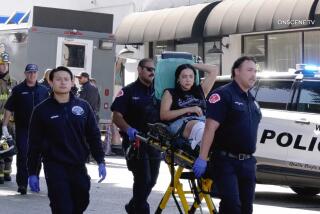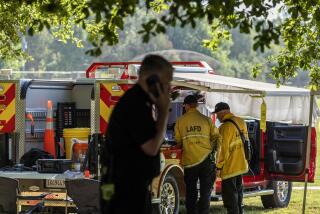Blasts are linked to aging infrastructure
A blast that killed one firefighter and injured another this week in Westchester was a freak occurrence and indirectly the result of the decaying underground infrastructure, officials said Friday.
Firefighter Brent A. Lovrien, 35, was fatally injured Wednesday when a spark ignited combustible smoke behind an electrical panel door that he was trying to open with a circular saw.
Smoke had migrated into the electrical room from the underground burning of a conduit 200 feet away. When underground pipes fail, it normally causes a power outage, not a dangerous fire, officials said.
Fire officials said Lovrien acted according to policy and had no way of knowing that using the saw could trigger an explosion. Los Angeles Fire Chief Douglas Barry said the policy for handling such situations would be reviewed.
The fatal blast also injured fire Engineer Anthony J. Guzman, 48, who emerged from surgery for multiple fractures in serious but stable condition.
During a 48-hour multi-agency investigation, technicians shut down power to 400 customers in a two-block commercial corridor along Sepulveda Boulevard, near Los Angeles International Airport.
Although officials insisted that another blast was unlikely, the problem at the root of the explosions is hardly uncommon. Threading under the city are 15,000 miles of aging electrical pipe -- much of it about 60 years old or more, said David Nahai, general manager of the city’s Department of Water and Power.
The electrical current travels through copper wiring that is wrapped in oil-soaked insulating paper. The entire bundle is encased in lead.
Over decades, that lead casing can develop cracks, causing arcing, said Aram H. Benjamin, the agency’s assistant general manager. Workers find the problem, then replace the old pipe with a modern synthetic. About half the underground pipes have been replaced.
In this instance, the arcing ignited the old oiled-soaked paper, which began to burn like a fuse. The fire began just under the corner of Sepulveda and La Tijera boulevards.
The first explosion happened about 2 p.m., blowing the manhole cover outside a Staples store 20 feet, said Battalion Chief John Miller. The second explosion occurred about 16 minutes later -- right above the source of the fire.
Smoke from the fire found its way into a 200-foot conduit that led into the tiny electrical panel room. The room stood behind a two-story office building that houses a credit union and a sandwich shop. By about 2:30 p.m., hazardous-materials specialist Lovrien was on the scene with fellow firefighters from Station 95.
Lovrien saw smoke coming from around the edge of the nearly airtight electrical panel room and, finding the door locked, ran to get the circular saw, said arson investigator Thomas L. Derby.
His composite blade struck the steel lock, throwing off a spark. The ensuing blast threw him back eight feet. He died from blunt-force trauma to the head, probably from the doors blowing off or from the saw, arson investigators said. The La Habra resident was divorced and had no children.
The force threw Guzman about six feet, even though he was standing well behind Lovrien.
“These series of events are very, very unusual,” Nahai said.
Present with Nahai, Mayor Antonio Villaraigosa and other officials at a Westchester news conference were comrades of Lovrien, a 13-year veteran whose sunny disposition earned him a matching nickname.
“His nickname is ‘Lovey,’ and that tells you everything about him,” said firefighter Anthony Pacheco, his voice cracking. Just days ago, Lovrien had insisted on working a shift for Pacheco so his colleague could have his birthday off.
--
More to Read
Sign up for Essential California
The most important California stories and recommendations in your inbox every morning.
You may occasionally receive promotional content from the Los Angeles Times.









